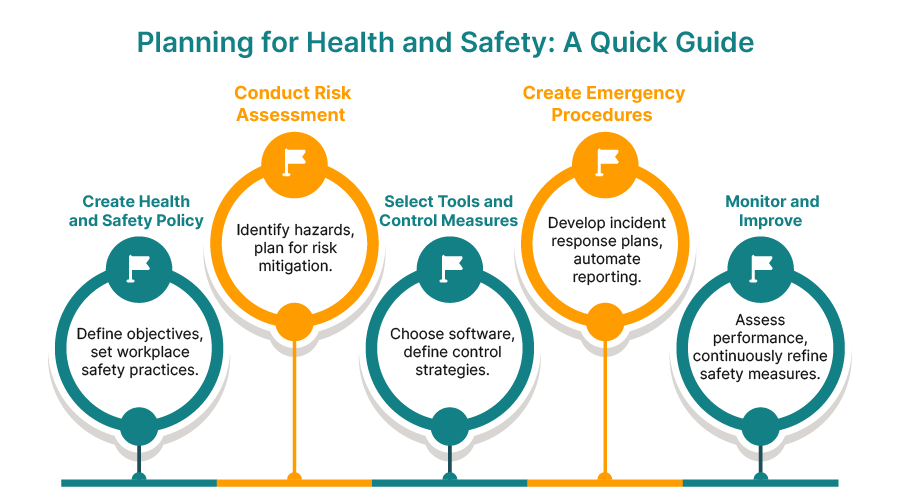Workplaces are inherently prone to health and safety hazards. Be it an office setting or a manufacturing floor, there is always the risk of accidents, injuries and health issues. This is why recognising these risks and planning for them is a regulatory requirement.
Employees and stakeholders must prepare for when something goes wrong in an organisation. This means having an HSE management system is a must. An HSE management system helps prevent accidents before they occur and manage them when they do occur.
In this article, we explore how planning for health and safety in a workplace is achieved using an HSE management system and the digital tools that enable this.
What Does Planning for Health and Safety in an Organisation Mean?
Planning for health and safety in your organisation means creating strategies and processes to prevent accidents and illnesses at the workplace. It involves identifying health and safety risks and implementing measures to mitigate them.
Planning for health and safety also involves setting up a robust HSE management system, which means setting health and safety objectives, ensuring compliance, training employees and establishing emergency procedures. This means setting up plans to ensure employee safety, protect their health, reduce liabilities and improve your organisation's overall performance.
What is an HSE Management System?
A Health, Safety and Environment Management System is a framework that organisations use to manage and address health and safety risks and environmental impacts. An HSE system aligns with standards such as ISO 45001 and ISO 14000 to help your organisation stay compliant.
Implementing the HSE management system as part of planning for health and safety involves setting HSE policies, identifying risks, defining the goals of the organisation, implementing the necessary systems, assigning roles and responsibilities, monitoring performance and continually improving.
Components of the HSE Management System
The structure of the HSE management system consists of two digital components that can be used to implement the system effectively. They are:
1. Occupational Health and Safety Management Software
The Occupational Health and Management System (OHSMS) Software ensures your employees are safe and healthy. This software manages your safety processes and automates the working HSE programs.
OHSMS is responsible for assessing risks, reporting, investigating and analysing incidents. All these processes are automated to ensure compliance with standards such as ISO 45001 and other industry-specific health and safety regulations. The HMS also defines transparent processes and guidelines in case of emergencies.
2. Environmental Management System
The second component of HSE is the Environmental Management System (EMS). This system ensures that your organisation systematically follows environmentally safe practices. It includes managing your organisation's structure, planning, resources and policies for environmental protection. EMS is a crucial component in ensuring ISO 14000 and ISO 45001 compliance.
EMS is an integral part of the safety management cycle because it lets you manage environmental risks while handling health and safety risks. This means it ensures that while you protect the environment, you also prioritise your employees' health and safety.
Why is an HSE Management System Important?
An HSE Management System is a central part of planning for health and safety. Here are some crucial reasons:

1. Protect Your Employees
The primary importance of an HSE Management System is to protect your employees from hazards in the workplace that may cause injuries or fatalities. OHSMS helps identify various sources of risks and control them to create a safer workplace.
2. Ensure Legal Compliance
The safety and health of your employees, as well as environment-friendly practices, is non-negotiable when it comes to staying compliant with major ISO standards and regulations. As an organisation, compliance reduces the risk of penalties, fines and liabilities.
3. Improve Operational Efficiency
An effective HSE Management System creates standardised procedures, reduces waste and prevents unexpected disruptions. This means it improves operational efficiency by facilitating the efficient use of resources. This can result in better overall productivity and profitability in the long run.
Planning for Health and Safety: Step-by-Step Guide
Implementing an HSE Management System should begin early on in every organisation. Early implementation allows you to integrate HSE principles into the core of how your business operates. Here is how to plan for health and safety with HSE software implementation.

1. Create a Health and Safety Policy
Create a policy that clearly states your organisation's objectives concerning health and safety. This policy will help define practices and workplace arrangements.
2. Conduct a Risk Assessment
At this stage, you will identify all potential workplace health and safety hazards and risks. These findings must be recorded to set up a proper emergency plan and steps to mitigate the risks.
3. Select Tools and Control Measures
Based on the risks identified, you can now define measures to eliminate and control the risks for higher system management safety. Effective HSE systems also include implementing appropriate digital solutions. At this stage, select OHSMS and EMS software that best fit your organisation's requirements.
These software come with diverse modules that let you customise them to integrate seamlessly into existing systems. Carefully select which processes you would like to manage, consider what kind of checks and controls you need to set up and how many of the health and safety processes you would like to automate.
4. Create Emergency Procedures
Develop plans to face emergencies and potential incidents. These plans should be carefully entered into the HSE management system software to ensure that drills, revisions and incident reporting are fully automated.
5. Monitor and Improve
Continuously monitor health and safety performance to ensure effective control measures are followed. When you notice aspects that need improvement, revise implementation and update control measures promptly.
In Conclusion
Planning for health and safety in your organisation must start with choosing a health safety management system that fits your organisation's goals and vision. A sound HSE management system ensures compliance with all established standards and makes creating a safe workplace easier.
Effivity's HSE management system software is an effective solution for all organisations to ensure they meet industry standards and regulations. With Effivity, you can streamline compliance and demonstrate your organisation's commitment to compliance and responsible operational practices.
Effivity's HSE management system software combines occupational health and safety aspects and safe environmental practices. The software is designed to be accessible, user-friendly and secure. Additionally, Effivity's HSE self-service app for mobile devices adds to your convenience.
Start implementing EHS Software in your organisation today by contacting the Effivity team to set up a consultation and a free trial!






























